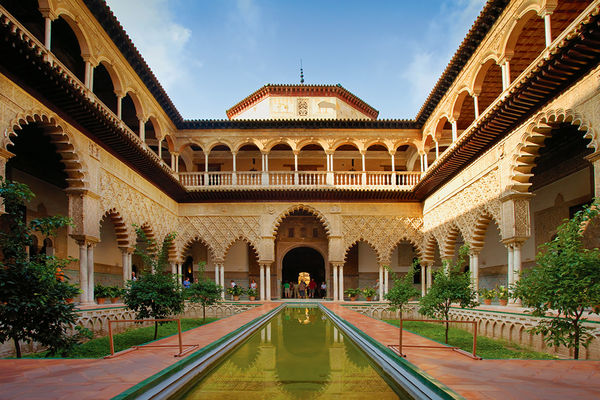Andalucía’s Big Three: Granada, Córdoba, and Sevilla
By Rick Steves

The quintessential image of Spain is the southern region of Andalucía, home of bullfights, flamenco, whitewashed hill towns, and glamorous Mediterranean resorts. And while much of the region's appeal is in its hill and coastal retreats, at the heart of Andalucía are three great cities: Granada, Córdoba, and Sevilla.
Granada is the famous last home of the (Muslim) Moors, who were driven out of Spain and back to Africa in 1492 during the Reconquista — the "reconquering" of Spain by Spaniards and Christians. Its top sight is the Alhambra, the last and greatest Moorish palace in Europe. Perched atop a hill and filled with colorful ornate stucco, scalloped filigree windows, exuberant gardens, bubbling fountains, and peaceful pools, the palace highlights the splendor of Moorish civilization in the 13th and 14th centuries.
While much of Granada feels Spanish, the Albayzín — the old Moorish quarter — retains its labyrinthine, Moroccan-souk feel. Located on a hill across from the Alhambra, it has stunning views across to the palace. I like to come here at sunset and eat at one of the view restaurants or picnic at the San Nicolás terrace, which comes with great Roma (Gypsy) music nearly all day long. Pop a few euros into the musicians' hat, and enjoy an open-air concert as good as many you might pay much more for.
Because of its significance in the Reconquista, Isabel and Ferdinand, the greatest king and queen of Spain, decided to use Granada as their capital. It was here that they listened to Christopher Columbus' final pitch for a sea voyage to the Orient and agreed to finance the trip. At the Royal Chapel, travelers can view the king and queen's elaborately carved Renaissance-style tombs.
About 100 miles northwest of Granada is Córdoba, another great Moorish city and home to the Mezquita, a splendid former mosque. Once the heart of Western Islam's cultural capital, the Mezquita has lost little of its grandeur over time — making it easy for visitors to imagine the ambience of Islamic Córdoba in its 10th-century prime. Inside the mosque, a huge 16th-century cathedral rises up from the center. When the Christians came, instead of destroying the mosque, they built their church in the middle of it.
Though some travelers stop in Córdoba for just a few hours and see little beyond the Mezquita, it's worth spending a night here to explore other aspects of the city: the untouristy modern district; the Jewish quarter, with a small yet beautifully preserved synagogue; and the city's pride — its patios. These delightful little edens serve as outdoor living spaces, hiding behind intricate ironwork gates and filled with flowers overflowing from their pots over whitewashed walls, amid colorful ceramics and doors.
Just 45 minutes by high-speed train from Córdoba is Sevilla, the capital of Andalucía. While Granada has the great Alhambra and Córdoba has the remarkable Mezquita, Sevilla has a soul.
Sevilla's two big sights are its cathedral and royal palace. Unlike in Córdoba, Reconquista Christians ripped down Sevilla's mosque to build a cathedral, announcing their intention to make it so big that "anyone who sees it will take us for madmen." Today it's still the second-largest church in Europe (by volume), after St. Peter's at the Vatican.
Just a few remnants of the former mosque remain, including the giant bell tower, which was once the minaret. Today, visitors can spiral up the ramp to the top of the bell tower for grand views. The cathedral also houses Christopher Columbus' tomb, which is being hoisted up by four kings.
Sevilla's old palace (Alcázar) is decorated with a mix of Islamic and Christian elements — a style called Mudejar. While the Alhambra in Granada was built by Moors for their own rulers, Sevilla's Alcázar was built by Moorish artisans in the Moorish style, mostly for Christian rulers. Spectacularly decorated halls and courtyards have distinctive Islamic-style flourishes, such as elaborate designs on stucco, colorful ceramic tile, lobed arches atop slender columns, and Arabic writing on the walls.
The palace is also where Queen Isabel administered the business of the country's nautical explorations. In the Admiral's Hall, Columbus recounted his travels and Magellan planned his around-the-world cruise. Today, exhibits call up the era of Columbus and Spain's New World dominance.
When visiting Sevilla, flamenco is a must. This music-and-dance art form has its roots Andalucía's vibrant mix of cultures. The men do most of the flamboyant machine-gun footwork while the women often concentrate on graceful turns and smooth, shuffling steps. In the raspy-voiced wails of the singers, you'll hear echoes of the Muslim call to prayer. And the colorful costumes and sultry, swirling dance moves are courtesy of the Roma people who settled in Spain. Performances range from serious concerts to tourist-centric shows to impromptu late-night sessions at casual bars — but even the touristy shows are rich with soulfulness.
Southern Spain's three big cities provide an interesting look at the Moorish influence on Spanish culture. Each is worth a visit for insight into this unique corner of Europe.

